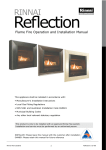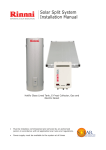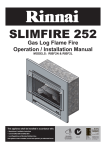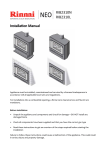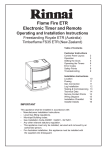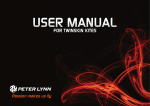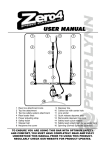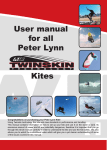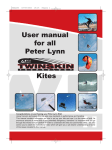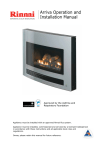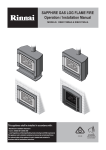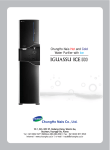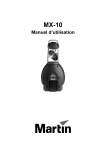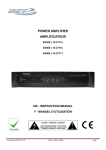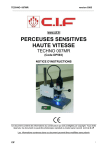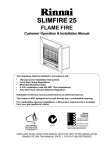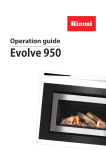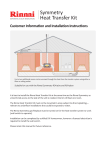Download Rinnai 0901 7042 Installation manual
Transcript
TIMBERFLAME COMPACT Operation and Installation Manual (for serial numbers 0901 7042 and above) Suitability Domestic heating appliance, suitable for living rooms and open plan areas. This heater is not designed: • To be built directly into a combustible opening, for combustible opening installations a Rinnai Zero Clearance Box and Flue Kit is mandatory • To be installed or operated in places where painting is taking place, or in places such as hair salons where there is a lot of dust and fluff, and where aerosols are used Appliance must only be installed with an approved Rinnai flue system. Appliance must be installed, commissioned and serviced by a licensed tradesperson in accordance will all applicable local rules and regulations. Please retain this manual for future reference. Rinnai New Zealand Compact Op/Install Manual: 10170-C 02-09 Limited Warranty Rinnai brings you peace of mind with a 2 year minimum warranty. TERMS AND CONDITIONS 1. During the 24 month period from date of purchase and subject to clauses 2 and 3 below, Rinnai New Zealand Limited (“Rinnai”) will, at its own discretion, either replace or repair any defective product at no charge to the customer. 3. Warranty claims may be invalid if not accompanied by details of the installing or supervising gas fitter’s registration number and the gas fitting certification number. 4. This warranty commences from the date of purchase. Proof of purchase is required at the time of any warranty claim. 2. This warranty covers manufacturing defects only. This warranty will not apply if (for example) the product has been improperly installed or is otherwise installed contrary to manufacturer’s recommendations, has been damaged during or after installation, has not been operated in accordance with operating instructions, or has been subjected to damage or abuse beyond that expected from conditions of normal use. 5. Servicing of the product is to be carried out by a Rinnai authorised service centre. All Rinnai appliances meet or exceed the safety standards required by New Zealand gas and electrical regulations. The company is constantly improving its products and as such specifications are subject to change or variation without notice. Please keep these instructions in a safe place for future reference. RECORD AND ATTACH YOUR PROOF OF PURCHASE BELOW: Your Retailer:__________________________________________________ Name:________________________________________________________ Address:______________________________________________________ _____________________________________________________________ Telephone:( _______ ) __________________________________________ Date of Purchase: ______ / ______ / _________ Rinnai New Zealand Compact Op/Install Manual: 10170-C 02-09 Contents Customer Information Limited Warranty 2 Introduction 4 Safety 5 General Information 6 Operation 8 Troubleshooting 9 Installation Information Before Installation 10 Specification 10 Appliance Location 11 Flueing - General Flueing Guidelines 12 Flueing - Masonry Installations and Flexiliner Flue Systems 13 Flueing - Decorative Fireplace Installations and Flueing 14 Installation - Preparation 15 Installation - Gas Connection 16 Installation - Installing the Logset 17 Testing Procedure 18 Commissioning 19 Installer Details 19 Wiring Diagram 20 Customer Contacts 20 WARNING Improper installation, adjustment, alteration, service or maintenance can cause property damage, personal injury or loss of life. For assistance or additional information contact Rinnai on 0800 RINNAI (0800 746 624). Rinnai New Zealand Compact Op/Install Manual: 10170-C 02-09 Customer Information - Introduction Made for New Zealand, made in New Zealand All Rinnai flame fires are designed and made here in New Zealand to suit our unique climatic conditions and the needs to New Zealand homeowners. A great all-round fire in a smartly designed package Adaptable and safe The Timberflame Compact has the flexibility to fit into even the tightest of masonry fireplaces. As with all Rinnai fires, it’s got built-in safety features including an overheat switch and flame failure detectors. Perfect features • • • stylish brushed stainless steel or matt black steel electronic push-button ignition 2-speed convection fan ensures even heat dispersal over a wide area Gas Consumption: Output: Efficiency: Heats Area Up To: Rinnai New Zealand 25 - 9 MJ/h (high to low) 5.0 - 1.6 kW 73% 56 - 78 m2 (depending on the region you live in) Compact Op/Install Manual: 10170-C 02-09 Customer Information - Safety Do not restrict warm air discharge by placing articles in front of the appliance. This appliance must not be used for any other purpose than heating. Young children should be supervised at all times. Hand or body contact with the appliance must be avoided. Do not spray aerosols while the appliance is operating. Most aerosols contain butane gas, this can be a fire hazard if used near the appliance. Do not allow anyone to post articles through into the heater. Do not allow anyone to sit, lean against or sleep directly in front of the appliance Do not allow curtains or other combustible materials to come into contact with the appliance Rinnai New Zealand Do not unplug the appliance while it is operating. Do not use power boards or double adaptors to operate this appliance. Compact Op/Install Manual: 10170-C 02-09 Customer Information - General Before operation Read these instructions to get an overview of how to operate, maintain and service your Timberflame Compact. Clearance to combustibles, mantles and surrounds Combustible clearances The appliance must not be installed where curtains or other combustible materials could come into contact with the heater. In some case curtains may need restraining. Mantles and surrounds A mantle is allowable providing it is outside the minimum clearances shown. For an additional overhang, 100 mm of vertical clearance is required for every 50 mm of added depth. For example, a 100 mm mantle depth requires 400 mm of vertical clearance. Combustible Clearances Mantles 300mm 50 mm maximum at 300 mm above 300mm 300 mm minimum from top of glass 300mm 1000mm Floor protection Heat emanating from this fire may over time affect the appearance of some materials used for flooring, such as, carpet, vinyl, cork or timber. This may be amplified if the air contains cooking vapours or cigarette smoke. To avoid this occurring, it is recommended that a mat be placed in front of the appliance. Electrical connection Appliance must not be located below a power socket outlet. If the supply cord is damaged and requires replacing, it must be replaced by a licensed tradesperson. This must be a genuine replacement part available from Rinnai. Rinnai New Zealand Compact Op/Install Manual: 10170-C 02-09 Customer Information - General Hearths A hearth is not necessary but can be used for decorative purposes or protection of sensitive flooring if required. Some general guidelines when installing a hearth such as in an existing masonry fireplace. • It must not obscure the front of the fire • The bottom of the appliance must be level with the top of the hearth so there is a continuous level • Size should be at least the width and depth of the fire • Remember to adjust the dimensions of the cavity to allow for the hearth Ensure continuous level Adjust dimensions of cavity to allow for the hearth In some instances an increase in hearth is desired. For the Timberflame range this may affect aesthetics. The increase in hearth height may cause you to look directly into the vents where the wiring is visible instead of the flame profile. Maintenance and servicing Maintenance Your heater needs very little maintenance to keep it looking good. All parts of the heater can be cleaned using a soft, damp cloth and mild detergent. Do not use solvents and do not attempt to clean the heater while it is hot or operating. Servicing Rinnai has a service and spare parts network with personnel who are fully trained and equipped to give the best advice on your Rinnai appliance. If your appliance needs servicing, please call Rinnai (0800 746 624) and select option 1 for a service centre in your area. For reliable operation Rinnai Flame Fires should be serviced every 2 years (including inspection of the flue system). If they are in a particularly dusty environment or subject to excess lint, for example dog hair or where there are newly laid carpets then annual servicing would be beneficial. Regular servicing is not covered by the Rinnai warranty. Do not attempt to carry out any service work other than that mentioned in the troubleshooting section. If you have any other faults or problems, please refer to your installer or call Rinnai. Rinnai New Zealand Compact Op/Install Manual: 10170-C 02-09 Customer Information - Operation HIGH LOW IGN The words HIGH, LOW and IGN are not part of the control panel. They have been displayed to highlight what each of the different settings mean. Ignition Firmly press the IGN button for 10 seconds and release. This operates the built-in safety device and starts the electronic spark (lights to pilot). If the pilot does not remain alight, wait 2 minutes before retrying ignition. If the heater does not ignite on initial use it may be due to air remaining in the gas supply line. Adjusting the heat Press the buttons from ‘LOW’ to ‘HIGH’. This will ignite additional burners as shown above. Turning off Press and release the buttons from ‘HIGH’ to ‘IGN’ until they are in the off position. The fan will stop when the heater cools. Fan operation The fan will operate automatically when the heater warms up and will stop when it cools. When the heater is on the ‘LOW’ setting the fan may turn off as the heater cools and restart when warm. In the event of a power failure If there is a power failure, turning the heater to the ‘LOW’ setting may allow the heater to continue operating without overheating. Remaining on the ‘HIGH’ setting will cause the overheat protection switch to activate. This will shut down the appliance. Rinnai New Zealand Compact Op/Install Manual: 10170-C 02-09 Customer Information - Troubleshooting Symptom Cause Solution Burner will not light No power present No gas present Power cut Air in gas pipe Ignition failure Ensure power cord is plugged in and turned on Ensure gas supply is turned on Re-ignite after power is restored Installer to do - purge air Repeat ignition steps Smell of gas Leaking gas Turn off gas at meter or LPG cylinder and call installer Fan not working Heat switch is not activated No power present Allow heater to run on HIGH for approximately 5 mins Ensure power cord is plugged in and turned on Small soot deposit Normal operation No action required Severe soot deposits forming on logs or glass Inadequate flue system, incorrect gas pressure or log misalignment Call a Rinnai Service Centre Condensation on glass Normal operation Allow heater to warm-up and condensation will disappear Streaky lines on glass Normal operation Clean glass During installation there will be an initial burning in period where some smoke and smell may be experienced. This is a normal part of the operation. The appliance is fitted with an overheat safety switch. Under overheating conditions this switch will shut off the appliance. If the appliance shuts off repeatedly servicing may be required. Abnormal flame pattern Each Rinnai Flame Fire has a distinct flame pattern. This should look the same every time you start your fire, after an initial warm up period of approximately 20 minutes. Abnormal flame performance and/or pattern can indicate a problem with your fire, such as blocked gas injectors or artificial logs/burn media have shifted from when the fire was first installed. There are some warning signs that could indicate a problem. • • • Unusual smell from the appliance Continued difficulty or delay in establishing a flame Flame appears either very short or very long Abnormal Normal • • Flame only burns part way across the burner Severe soot building up on the inside of the glass door If any of the above signs occur, please call Rinnai to discuss. Rinnai New Zealand Compact Op/Install Manual: 10170-C 02-09 Installation Information - General Before installation Unpack the appliance and components and check for damage. DO NOT install any damaged items. Check all components have been supplied and that you have the correct gas type. Read these instructions to get an overview of the steps required before starting the installation. Failure to follow these instructions could cause a malfunction of the appliance. This could result in serious injury and property damage. Specification information Data Plate Inside appliance - bottom panel front right hand side Dimensions H-645 mm, W-750 mm, D-277 mm Fan Type Tangential 2-speed, rating 28 W Flue - Masonry Rinnai strongly recommends the use of a Rinnai Flexiliner Flue system. Failure to meet this criteria may result in an unsafe situation. Installation without a flexiliner flue is permissible as long as the chimney is checked for soundness and ability to achieve a good draw. Terminal 43 mm x 245 mm rear discharge (spigot) Flue - Decorative Natural draft twin skin flue. Termination, an approved 100 mm cowl must be fitted to all installations. Decorative chimney installations require a Zero Clearance Box and Zero Clearance Flue Kit. Flue dimensions, outer - 150 mm, inner - 100 mm. Gas Connection ½ “ BSP male flare to barrel union Gas Type NG or LPG Noise Level 49 dB(A) Power Consumption High 80 W, Standby 4 W Weight 39 kg Rinnai New Zealand 10 Compact Op/Install Manual: 10170-C 02-09 Installation Information - Location Positioning the appliance Main points governing location are flueing and warm air distribution. The heater must not be installed where curtains or other combustible materials could come into contact with the appliance. In some cases curtains may need restraining. Standard flued appliances draw the air for combustion from the room itself so there is a need for permanent ventilation (for example, fixed open louvres). This fixed ventilation must be provided as per NZS:5261. Enclosure requirements The heater must be positioned on a flat level surface that allows free movement of the appliance. • Masonry installations, use a slurry of sand and cement to level base as required • Decorative installations, the zero clearance box needs to be supported, either construct a base using board with supporting joists or support with the frame itself Enclosure Dimensions Masonry Installation Decorative Fireplace W-Width 590 - 740 mm 680 mm H-Height 640 mm 675 mm D-Depth 360 mm 370 mm All dimensions provided are critical to the installation of this appliance and must be adhered to. Electrical connection This appliance has a power cord with a 3-pin plug supplied. The power cord passes through the slot in the lower left or right hand side of the heater front assembly. POWER CORD RUBBER GROMMET Rinnai recommends that the heater be plugged into a 230 V 10 Amp earthed power point. The power point must be a minimum of 300 mm to the side and must not be above the unit. Alternatively the unit can be direct wired if the power supply is to be concealed. The electric isolation switch must be accessible after the appliance has been installed. The electrical cord is not fire rated and should not come into contact with the fire. Rinnai New Zealand 11 Compact Op/Install Manual: 10170-C 02-09 Installation Information - Flueing General flueing guidelines Every appliance requires a flue system that will draw effectively and safely clear flue products under all wind and climatic conditions. It is the responsibility of the installer to ensure that the appliance is provided with an effective flue. Some guidelines to assist with flue design is listed below. These must be read and modified as necessary with reference to the particular installation. Flue Terminal Locations Must be compliant with ‘Clearances Required for Flue Terminals’ from NZS:5261.2003. Flue Length This is required for adequate draw and prevents spill-back of combustion products that can cause safety sensors to shut down the fire. • • Minimum Maximum 3.6 m vertical (1.2 m of vertical flue required before any bend or offset) Rinnai recommend a maximum flue height of 8 m Flue Systems For new fireplace installations (installations into a combustible opening) a Rinnai Zero Clearance Box and Flue Kit is a mandatory requirement to meet warranty conditions. For masonry installations, to ensure adequate draw, Rinnai strongly recommends the use of a Rinnai Flexiliner Flue System. Failure to meet this installation criteria may result in an unsafe situation. Installation without a flexiliner flue is permissible as long as the chimney has been checked for soundness and ability to achieve a good draw. Shared Flues Gas appliances must not be connected to a chimney or flue serving a separate solid fuel burning appliance. Flue Cowl Clearance To ensure the products of combustion are cleared, adequate clearance from the building is required. The following guideline is recommended. Flue cowl should have a 500 mm clearance from any part of the building. This also applies to steeped and pitched roofs which should be 500 mm clear of the ridge line as shown below. Lesser clearances may provide perfectly adequate flue systems depending on the installation. 500 mm 500 mm 500 mm 500 mm Rinnai New Zealand 12 Compact Op/Install Manual: 10170-C 02-09 Installation Information - Flueing Masonry installations and flexiliner flue systems Check dimensions of opening Ensure opening is within range provided and if necessary bring them to the required dimensions. Also check chimney height as inadequate height can affect product performance. Some installations may require the chimney height to be extended to reduce down drafts. Install a Rinnai flexiliner flue system Ensure a minimum vertical rise of 1.2 m before any change of direction. Avoid sharp bends as this will restrict the chimney’s ability to draw. Installation without a flexiliner is permissible as long as the chimney has been checked for soundness and ability to achieve a good draw. Some criteria for checking soundness: • All loose/broken bricks must be replaced or repaired ensuring the chimney is of sound construction and does not leak • Chimney must be swept clean and be free from soot and creosote that may have built up if previously used for a solid fuel fire • Any damper plate must be fixed in the open position or removed • Any underfloor air supply to the fireplace must be completely sealed off to prevent secondary air draw • An approved chimney cap and cowl must be installed Rinnai New Zealand 13 640 mm Check flueway Ensure there are no obstructions. Provide a firm, flat and sealed base otherwise noise and vibration may result. Sealed means no holes or openings in the fireplace. 590 - 740 mm 360 mm minimum depth 100mm Chimney Cowl 100mm Galvanised Chimney Flashing 300 x 400 mm 100mm Top Flexi Flue Adaptor Aluminium Flexible Flue Flexiliner Flue Adaptor Compact Heater Compact Op/Install Manual: 10170-C 02-09 Installation Information - Flueing New fireplace installations and flueing Flat wall Construct frame Install zero clearance box Install flue Plaster and paint Install heater For installations into new fireplaces (installation into a combustible opening) a Rinnai Zero Clearance Box and Zero Clearance Flue Kit is required. Failure to meet this installation criteria will void any product warranty. Installing the heater last minimises building debris/dust entering the fire which is common when building or renovating. Construct frame and install a zero clearance box BEFORE the dry wall Refer to instructions supplied with the zero clearance box. Installation of the zero clearance box needs to be on a level base. If this is not done the appliance may twist and become damaged and will void any product warranty. 675 mm 370 mm 680 mm Install the flue The flue should be self supporting. This is usually done at the framing stage with flue supports (x2) provided in the flue kit. These are riveted to the flue. The flue kit components are twinskin and require a 25 mm clearance from combustibles. Flue Inner flue Outer flue must be ≥ 25 mm from inner flue Combustible Material Complete electrical connection Electrical cord is not fire rated and should not come into contact with the fire. An electrical isolation switch is also required so positioning of this switch needs to be considered when assessing where to install the unit. Rinnai New Zealand 14 Compact Op/Install Manual: 10170-C 02-09 Installation Information - Installation Plinth Supplied with Heater 2 7 Air Slots 5 10 Air Slots 3 11 6 1 9 4 8 Preparation 1. Position plinth into cavity or zero clearance box. The plinth correctly positions the heater at the required level and the air slots at either end allow air to pass through and cool the heater and/or zero clearance box 2. Place the heater on a flat surface and remove the 3 screws holding the fascia (1) in place. 3. Pull the bottom of the fascia forward until clear of the gas control buttons and lift up to remove from frame. 4. Remove the 2 screws holding the top glass retainer in place and lift off (2). 5. Loosen the 2 screws holding the lower glass retainer in place and remove glass panel (3). 6. Remove the barrel elbow from the gas connection bracket on the base of the heater at the front right hand side (4). Make sure that the gas flare fitting and gas supply pipe are clean and free from damage. Fit together ready for fitting to the heater. 7. For installation into a masonry fireplace, the foam strips (5) must be attached to the heater to provide a seal around the fireplace. If this does not provide an adequate seal an alternative must be used. 8. Insert the heater into the cavity on top of the plinth, taking care when inserting the gas supply tube. 9. There are 4 levelling screws at the base of the heater held in place with locknuts. If the heater does not sit flat when in place it may be necessary to adjust these. The front screws are accessible with the front of the heater removed. If adjustment of the rear feet is required, the burner assembly and gas control will need to be removed (6). 10. Once the heater is sitting flat attach it to the wall using the 4 holes (2 per side) on the front flanges. Rinnai New Zealand 15 Compact Op/Install Manual: 10170-C 02-09 Installation Information - Installation Gas connection Gas pipe sizing must consider the gas input to this appliance as well as other appliances in the premises. The gas meter and regulator must be specified for the total gas rate. An approved sizing chart such as the one in NZS:5261 should be used. Copper supply should be run leaving a flared connection at the position shown. The gas supply terminates inside the heater and enters the appliance from the rear. As this is a flare connection, sealant is not recommended. 260 79 43 ½" BSP MALE FLARE Purge supply of air and debris All foreign materials such as filings must be purged from the gas supply, as they may cause the gas control valve to malfunction. Fit heater into place When the heater is in place and properly secured, attach the gas supply to the supplied barrel union and tighten. On completion of work a gas leak test must be carried out. Use a soapy solution on all gas connections. Leaks will be visible when the soapy solution forms bubbles. When finished, wipe soapy solution with a rag to remove residue. Rinnai New Zealand 16 Compact Op/Install Manual: 10170-C 02-09 Installation Information - Installation Installing the logset 1. Logset preparation Remove logset and granule packet from packaging. To achieve the correct location of the logset hold as shown below. 2. Logset positioning into combustion chamber Tilt the back of the logset upwards locating the front feet (1) behind the unpainted inner horizontal lip (2). Ensure sides do not touch the combustion chamber walls. Rotate the back of the logset down using the location of the front feet as pivot points. 3. Logset correctly positioned Logset will look like picture shown when installed correctly. 1 2 3 4. Adding granules Gently place granules in front of the main log. Level it with a pencil or screwdriver and remove excess material. Do not pour granules as dust particles from plastic bag may block the burner ports. If the logset is to be removed for any reason the granules must be removed first. Any material that prevents the logs from sitting flat on the burner top can upset the burning pattern and performance of the heater. 5. Replace glass Replace the glass ensuring the joint in the glass sealing tape is at the bottom. Rinnai New Zealand 17 Compact Op/Install Manual: 10170-C 02-09 Installation Information - Testing Testing procedure 1. Turn gas supply on and plug the unit into the power supply. 2. Refer to data plate for burner pressure and remove front cover panel. 3. Remove test point screw and attach manometer to test point. The test point is on the front injector block. 4. Light heater, turn to high setting and check pressures. 5. If adjustments are necessary, the regulator is situated on the front of the gas control and should be set to the pressures on the data plate. 6. After checking pressures, turn the unit off, remove manometer and replace test point screw. 7. Turn the heater on and off a few times to check ignition. 8. When you are satisfied that the heater is working correctly, reassemble the panels. All burner aerations are factory preset and cannot be adjusted. If you are unable to get the unit to operate correctly refer to troubleshooting section of this manual before contacting Rinnai. It may take approximately 2 hours of operation for the logs to achieve their full flame pattern and glow. During the initial burning in period, some smoke and smell may be experienced. The heater should be run on the high setting in a well ventilated room until these dissipate. It is the responsibility of the installer to check that under normal conditions of the appliance, all flue gases are exhausted to the outside atmosphere and that there are no spillage of combustion gases into the room Rinnai New Zealand 18 Compact Op/Install Manual: 10170-C 02-09 Installation Information - Commissioning Complete the installation and commissioning checklist below and make sure this manual is left with the customer. Explain to the customer about the use and care of the unit and understands the instructions and operation of the appliance. If operating without a dress guard please following safety instructions to prevent the risk of injury. NO YES Appliance positioned in a suitable location? (i.e. clearances, combustibles etc.) Was a Rinnai approved flue system installed and is the flue drawing effectively? Has specified gas pressures been checked and set? Is the logset located correctly? Have the granules been placed evenly and on top of the burner and free of dust? Has the appliance been tested for correct operation? Is the customer fully aware of the operating procedure? Installer Details Company name:______________________________________________________________ Installer name:_______________________________________________________________ Address:____________________________________________________________________ ___________________________________________________________________________ Phone:_______________________________ Mobile:______________________________ Permit number for installation:___________________________________________________ Signed:______________________________ Rinnai New Zealand Date:_______________________________ 19 Compact Op/Install Manual: 10170-C 02-09 Wiring Diagram TC FAN BL ( +) (-) R OHS FAN S WITC H HI/ LOW (MIC R O) 1 BL 2 R 3 W W SV W FAN S WITC H ON/OFF (T HE R MAL) + - 2 1 S PAR KE R BR BL BL E LE CTR ODE W BL BR 220~240 v 50 Hz 2 1 BL W G /Y 1 2 BL W IGN S WITC H (MIC R O) R BL BR W G/Y Red Blue Brown White Green/Yellow OHS Overheat Switch SV Solenoid Valve TC Thermocouple If the supply cord is damaged or requires replacing, it must be replaced by a licensed tradesperson. This must be a genuine replacement part available from Rinnai. Rinnai New Zealand Consumers: Installers: 0800 RINNAI (746 624) 0800 TO RINNAI (86 746 624) Address: 105 Pavilion Drive, Airport Oaks, Mangere, Manukau PO Box 53177, Auckland Airport, Manukau 2150 Phone: Fax: (09) 257 3800 (09) 257 3899 Email: Websites: [email protected] www.rinnai.co.nz and www.rinnai-tradesmart.co.nz 20 Compact Op/Install Manual: 10170-C 02-09





















